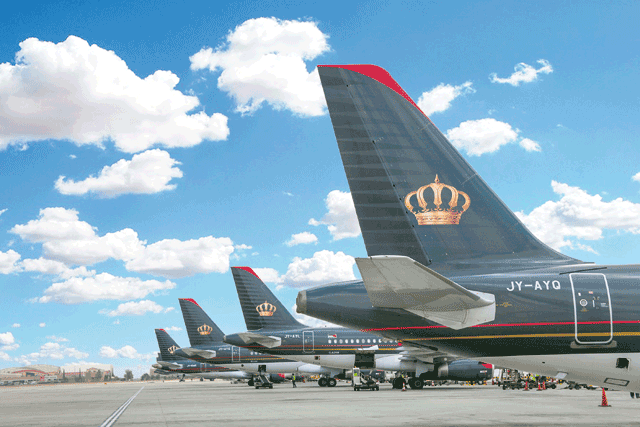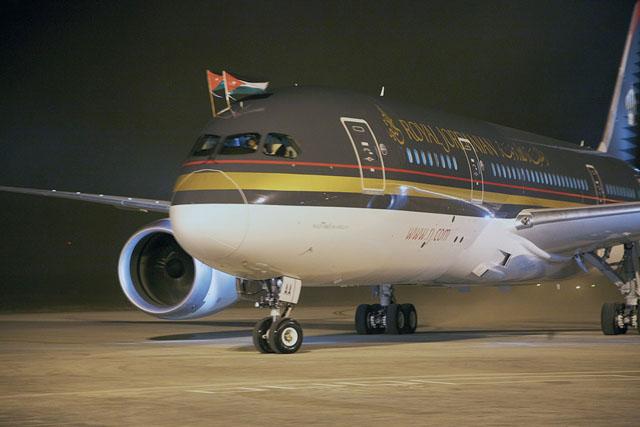You are here
2015 marked beginning of Royal Jordanian's real transformation — Hafez
By JT - Apr 14,2016 - Last updated at Apr 14,2016

Royal Jordanian (RJ) Chairman Suleiman Al Hafez (centre) speaks on Thursday during the ordinary general assembly meeting of shareholders (Photo courtesy of RJ)
AMMAN — Royal Jordanian (RJ) Chairman Suleiman Al Hafez told shareholders on Thursday that 2015 marked the beginning of the process of real transformation undergone by the national airline in terms of financial results and profits.
According to an RJ press statement, the chairman indicated that since the beginning of 2015, the company started to implement the 2015-2019 business plan, which came after a detailed analytical study of income, expenditure, route network, fleet, cost and nature of financial restructuring.
"The study concluded that maximising revenues and reducing expenses in a manner that would not affect the safety standard, which is a top priority for the company, and the services offered to RJ passengers are two important factors and the cornerstone to the advancement of the company," Hafez said.
Speaking at the ordinary general assembly meeting of shareholders that was attended by RJ President/Chief Executive Officer Suleiman Obeidat and RJ auditors Ernst and Young, he added that the business plan was based on six main pillars.
"The first focusses on the route network and fleet," Hafez continued. "The company took the decision to close eight destinations due to their poor feasibility and suspended operations to eight other cities for security reasons, and it opened five new destinations: Tabuk, Najaf, Ankara, Jakarta and Guangzhou.
At the same time, RJ phased out a number of aircraft and introduced five new Boeing 787s.
The second pillar of the plan involves boosting the market share locally and internationally by increasing the number of passengers from and to Jordan and by increasing the transit traffic via Queen Alia International Airport.
Revenue management is the third pillar of the plan. The company has taken a number of measures to boost revenues, with a focus on ancillary revenues, which are part of the fourth pillar.
The fifth pillar is the efficient use of fuel in order to lower cost. The company is implementing a number of initiatives that reduce fuel consumption, including continuously renewing its fleet and negotiating with fuel suppliers to obtain best prices.
The sixth pillar involves an analysis of the aircraft ownership structure. The company will study the best ways to meet its needs and achieve its interests in regards to the options of the operational and/or capital lease.
Regarding the procedures undertaken by the company to raise its capital, Hafez said in the press statement that the company worked on the implementation of the decision taken at the previous general meeting, including restructuring the company's capital by reducing it to become 46,405,342 shares/dinars and increasing the authorised capital by JD200 million, making its total authorised share capital 246, 405,342 million shares/dinars. The board of directors decided to proceed with increasing the subscribed capital through two phases.
The first phase involved the first part of the increase in the amount of 100 million dinars/shares, while the second part of the increase (also in the amount of 100 million dinars/shares) to be carried out through a second phase based upon the company’s results and performance.
The shares of the first part of capital increase were offered to the main shareholders and the implementation of these procedures was complete. The offering represented 100 million shares at a cost of JD1 per share. RJ’s management looks forward to commencing the second phase of the capital increase in the future.
RJ contributes about 3 per cent of the country's GDP, exceeding the contribution of other key sectors.
The business plan, said Hafez, also included a quite successful rescheduling of the company's debts; RJ closed $275 million loan facility deal at the end of 2015.
The facility carries a tenor of five years and its proceeds will be primarily utilised to pay RJ’s existing bank debts and further support the company’s ongoing strategic growth and turnaround plans in the short and medium run, particularly those regarding the modernisation of the fleet.
RJ will continue modernising its fleet by introducing three new Boeings 787, one at the end of 2016, a second at the beginning 2017 and a third in 2018. RJ introduced five 787s in 2014.
According to Hafez, the drop in fuel prices was not the main reason for the profit made by the company last year, despite their importance on airline budgets.
He said that RJ reduced ticket prices due to fierce competition, but the lower fuel prices helped offset some of the losses incurred because of the drop in ticket prices.
In 2015, RJ halted two significant routes to Sanaa and Aden, incurring losses of JD12.3 million, which was offset by lower oil prices as well.
While the lower fuel prices offset mostly the mentioned two factors, the profit achieved was the result of the staff's keenness to carry out the company’s business plan.
Hafez stressed that Royal Jordanian will keep working to achieve its ambitious plan for the coming years, confident in its goals and vision.
"The company is now on the right track. It is able to control the variables that affect the airline industry, in terms of fleet and network, despite the challenges it faces due to the political instability in Syria, Iraq, Libya and Yemen, where it has suspended its operations, incurring losses," the press statement said.
At the meeting, a new board of directors was elected.
Government Contributions Managing Company holding 5 seats, the Social Security Corporation holding one seat, Mint Trading Middle East Limited holding one seat, in addition to Michael Nazzal and Mohammad Ali Bdeir.
Related Articles
AMMAN — Royal Jordanian (RJ) held an extraordinary general assembly virtually on Tuesday, headed by RJ Board of Directors Chairman Said Darw
The Royal Jordanian’s (RJ) general assembly agreed on Saturday on a restructuring plan for the national carrier that entails raising capital by JD200 million.
The government is committed to supporting Royal Jordanian (RJ) to enable it to continue its role as the Kingdom’s flag carrier, Prime Minister Abdullah Ensour said Saturday.


















